Madhubala
Madhubala (born Mumtaz Jehan Begum Dehlavi; 14 February 1933 – 23 February 1969) was an Indian film actress, film producer and playback singer who worked in Indian films. One of the most popular and highest-paid actresses of her time, she appeared in 73 Bollywood films in a career spanning over two decades.[1] In the media, she is referred to as one of the most beautiful, greatest and influential personalities of Indian cinema.[2][3]
Madhubala | |
|---|---|
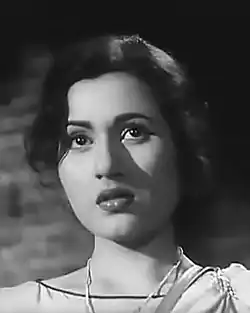 Madhubala in Kala Pani (1958) | |
| Born | Mumtaz Jehan Dehlavi 14 February 1933 |
| Died | 23 February 1969 (aged 36) |
| Resting place | Juhu Cemetery, Santacruz, Mumbai, Maharashtra, India |
| Nationality | British Indian (1933–1947) Indian (1947–1969) |
| Other names | Baby Mumtaz, Marilyn Monroe of Bollywood, The Venus of Indian Cinema |
| Occupation |
|
| Years active | 1942–1964 |
| Spouse(s) | |
| Relatives | See Ganguly family |
Madhubala began her career playing juvenile roles in the early 1940s, first of which was in Basant (1942). At the age of 14, she switched to lead roles with 1947 drama film Neel Kamal. Her rise to prominence came after starring in the thriller Mahal (1949), following which she became one of the most bankable Bollywood stars of the subsequent decade. In 1952, Madhubala received offers from Hollywood but her father refused. The same year, she appeared in the Theatre Arts Magazine where, in its August 1952 issue, she was featured in an article with a full page photograph under the title: "The Biggest Star in the World – and she's not in Beverly Hills".
Apart from appearing in several commercially successful films, Madhubala also went on to earn critical praise for her portrayal of a social worker in Amar (1954), a modern miss in Mr. & Mrs. '55 (1955), a cabaret dancer in Howrah Bridge (1958) and two sisters with constrasting personalities in Kal Hamara Hai (1959). Her highest-grossing releases came with the comedy Chalti Ka Naam Gaadi (1958), the romantic musical Barsaat Ki Raat and the magnum opus Mughal-e-Azam (both in 1960). Her performance in Mughal-e-Azam as the ill-fated courtesan Anarkali was widely acclaimed by critics, who labelled it as the finest given by her; and earned her her only nomination for Filmfare Award for Best Actress.[3] In the early 1960s, Madhubala continued starring in commercial successes such as Jhumroo (1961), Passport (1961) and Half Ticket (1962), but her work in this decade was limited to five releases only. Her last completed film was the posthumously released Jwala (1971).
Madhubala's private life received much attention. She was known for keeping low public profile, was not seen at parties and film premiers and rarely gave interviews. She had a long relationship with actor Dilip Kumar, but chose to marry her frequent co-star Kishore Kumar in 1960. Madhubala's life and career was cut short when she died in 1969 from a prolonged illness at the age of 36. Her beauty and comparison with Hollywood actress Marilyn Monroe eventually earned her the titles The Venus of Indian Cinema and Marilyn Monroe of Bollywood.[4][5][6] Coincidentally, both were 36 when they died.
Early life and education
Madhubala was born on 14 February 1933 as Mumtaz Jehan Begum Dehlavi, the fifth of eleven children in Delhi, British India (present day in India). Her parents were Ataullah Khan and Aayesha Begum. She had ten siblings out of whom only four survived to adulthood. Her father, Ataullah Khan belonged to the Yousafzai tribe of Pashtuns, and lived in Peshawar valley which includes the present-day regions of Mardan and Swabi, now in Pakistan, with his family.[7] After losing his job at the Imperial Tobacco Company in Peshawar, he relocated the family to Delhi and then Bombay. The family endured many hardships. Madhubala's three sisters and two brothers died at the ages of five and six. The dock explosion and fire of 14 April 1944 wiped out their small home. The family survived only because they had gone to see a film at a local theatre.[8]
With his six remaining daughters to provide for, Khan, and the young Madhubala began to pay frequent visits to Bombay film studios to look for work. At the age of 9, this was Madhubala's introduction to the movie industry, which would provide financial help to her family.[9] Madhubala spoke her native language Pashto at home and was proficient in Urdu and Hindi. She couldn't speak a word of English but yearned to learn the language. She later took classes of English and became fluent in that language. Madhubala learned driving at the age of twelve and sometimes enjoyed long drives.[10]
I am not a spendthrift for the simple reason that I do not know what to spend money on. I do not have a passion for jewellery and clothes. I do not travel. I do not go out much. By God's grace I have all necessities of life and I am happy.
— Madhubala
Acting career
1942–47: Career as a child artist
.jpg.webp)
Madhubala's first film appearance was in Basant (1942). She acted as the daughter to Uma, the character played by actress Mumtaz Shanti and was credited as Baby Mumtaz in the film. Basant became the highest-grossing Indian film of that year.[11]
A nine-year old Madhubala, then a child artist often tottered around various studios of Bombay in search of work and made several friends there. Around the same time, another child artist Baby Mahjabeen also visited these studios and was known to Madhubala. This Baby Mahjabeen later on, became one of the most sought after stars and her contemporary – Meena Kumari.[12] Madhubala was a fan of Kumari and said: "She has the most unique voice. No other heroine has it".[13]
After starring in the film Basant, Madhubala, as Baby Mumtaz starred in Mumtaz Mahal (1944) and in director Kidar Sharma's 1945 film Dhanna Bhagat. More films of Baby Mumtaz followed in 1946 such as Pujari, Phoolwari and Rajputani. Phoolwari was the third highest-grossing film of that year and starred Motilal and Khursheed Bano in lead roles. Rajputani was her last film as a child artist.
1947–48: Early career as a lead actress
In 1946, Kidar Sharma, one of the most successful and popular directors of those times, decided to make a film titled "Bichara Bhagwaan", based on the lives of untouchables and starring his wife Kamla Chatterjee and Jairaj in lead roles. However, Chatterjee died on the very day of the film's announcement, and Sharma went into deep mourning until he decided to restart the production of the film in late 1946.[14] He replaced Jairaj by his assistant Raj Kapoor in a haste, and cast Madhubala, who was going to play a child role in the film, as the leading lady. When the financiers appeared to be apprehensive of Sharma casting two newcomers, he sold his own plot and produced the film, which was now titled Neel Kamal.[14]
— Kidar Sharma on casting Madhubala as lead in Neel Kamal
Therefore, Madhubala's first lead role was in Sharma's Neel Kamal, where she was credited as "Mumtaz". Released four months prior the partition of India in 1947, the film saw Madhubala play a princess who is ousted from her palace after a coup and sent to live with an untouchable family.[11] Neither the film nor Madhubala got enough popularity and it proved to be a commercial failure.[15] Director Mohan Sinha, when signing her for his drama Mere Bhagwaan (1947) rechristened her as "Madhubala", literally meaning "honey belle". From there on, she assumed the name Madhubala and Neel Kamal became her last film in which she was credited as Mumtaz.[16][17] Madhubala's next releases in 1947 also starred her alongside Kapoor - Chittor Vijay and Dil Ki Rani. Both of these films failed to find a wider audience.
The series of poorly received films continued with Mere Bhagwaan (1947), Parai Aag (1948), Amar Prem (1948) and Desh Sewa (1948), all of which bombed at the box office. In her last release of 1948, Madhubala starred as a rural girl named Shobha in K.B. Lall's Lal Dupatta. Her enactment garnered her positive reviews; Baburao Patel of filmindia wrote, "Madhubala plays Shobha beautifully and proves herself at once competent and versatile in both light and pathetic sequences. Her dialogue is also emotionally delivered."[18] Lal Dupatta emerged as her first commercial success and had a good run at several theatres.[19][20]
1949–54: Super stardom and Career setbacks

Madhubala rarely had any financial succees between 1948 and early 1949 but her performances were regularly praised by film critics. Her first release of 1949 was the thriller Sipahiya, in which she, according to Baburao Patel, gave an "excellent performance as a romantic maiden."[21] Films which followed were the musical Paras, in which she played a supporting role alongside Kamini Kaushal and Rehman, and another thriller Aparadhi, where her enactment of an independent woman garnered her positive reviews. It was stated that she made Kaushal "look like an amateur" in the former,[22] and was called the "only silver lining" of the latter.[21]
Bombay Talkies's Mahal, theatrically released on 12 October 1949 transformed Madhubala into an overnight superstar. Though it was a role intended for Suraiya, eventually went to Madhubala after being screen-tested among many leading ladies of that time. She was selected by the film's director Kamal Amrohi, who was also making his directorial debut with this film. This film also established Lata Mangeshkar as a leading playback singer. Its songs, particularly "Aayega Aanewala", are perennial favourites. The film was India's first reincarnation thriller film. It was a major box office success and paved way for Indian gothic fiction.
After Mahal, Dulari was released in the same year and had Madhubala with Geeta Bali, Shyam, Jayant and Suresh. The film has the hit song "Suhani Raat Dhal Chuki" sung by Mohammed Rafi and featuring Suresh.[23] Dulari was a commercial success, year's eighth-highest-grossing film and was remade in Telugu as Sobha (1958).
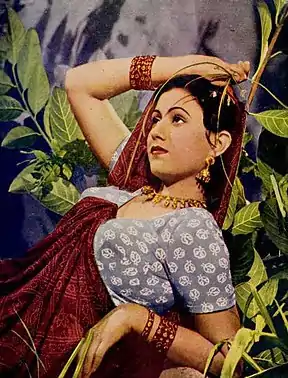
During the 1950s, Madhubala took starring roles in almost every genre of film being made at that time. Her 1950 film Hanste Aansoo was the first ever Hindi film to get an "A" – adults only – rating from the Central Board of Film Certification. Badal (1951) starred Madhubala and Premnath in lead roles. The film has the popular song "Do Din Ke Liye" sung by Lata Mangeshkar. It was a box-office hit. She was the archetypal fair lady in the swashbuckler Badal, and following this, an uninhibited village beauty in Tarana (1951). Tarana was the first film that started Dilip Kumar and Madhubala together. The duet "Seene Mein Sulagte Hain Armaan" became popular and was sung by Talat Mehmood and Lata Mangeshkar for Dilip Kumar and Madhubala respectively.
Hollywood interest
Although Madhubala didn't become the first Indian actress in Hollywood, it is said that she was the first Indian woman in Hollywood. In the early 1950s, as Madhubala became popular,[24] she caught the interest of Hollywood when ace photographer James Burke visited India and photographed her for the Life magazine. In their feature of her, Life called her "the biggest star" in the international industry. She was photographed extensively for this feature by photographer James Burke. She appeared in the American magazine Theatre Arts where, in its August 1952 issue, she was featured in an article with a full page photograph under the title: "The Biggest Star in the World – and she's not in Beverly Hills". The article described Madhubala's immense popularity in India, and explored her wide appeal and large fan base. It also speculated on her potential for international success.[8] Academy Award winner American director Frank Capra, while visiting Bombay for International Film Festival of India, was desperate to give her a break in Hollywood, but her father Ataullah Khan declined this offer. According to him, Madhubala was meant to stay in India and act in Hindi films only.[25] Between the period of 1952–55, most of her films either fared average or poorly. She played the traditional ideal of Indian womanhood in Sangdil (1952). The film stars Dilip Kumar and Madhubala in lead roles and was an adaption of the classic novel Jane Eyre by Charlotte Brontë.[26] Rail Ka Dibba (1953) had Shammi Kapoor and Madhubala in lead roles. The film failed at the box office. Armaan (1953) starring Dev Anand and Madhubala in lead roles performed moderately.
Bahut Din Huwe (1954) was directed by S.S. Vasan and was produced by Gemini Studios. Apart from Madhubala, the film had Savitri and Lalita Pawar. All the songs of the film were sung by Lata Mangeshkar. The shooting of the film took place in Madras. During the shooting of this film, it was discovered that Madhubala was suffering from a congenital heart defect.[27] Amar (1954) was directed and produced by Mehboob Khan and starred Dilip Kumar, Madhubala, Nimmi and Jayant. The film is a psychological drama, exploring a violent act between the main characters and the crisis of conscience that rocks them. It is the story of a prosperous lawyer Amar (Dilip Kumar), who is in love and engaged to a young woman Anju (Madhubala) but rapes a poor local village woman, Sonia (Nimmi). The rest of the story deals with the aftermath of this tragic event, will all the inevitable undercurrents of guilt, penitence and pervasive heart break that stems from it. Both Bahut Din Huwe and Amar failed at the box office.
1955-60: Reigning years

Madhubala gave a flamboyant performance in Guru Dutt's satire Mr. & Mrs. '55 (1955), and the film revived her career once again. It revolves around Anita, a wealthy heiress, and a struggling cartoonist, Pritam (Dutt). Mr. & Mrs. '55 has hit songs, "Jaane Kahan Mera Jigar Gaya Jee" (a duet sung by Geeta Dutt and Mohammed Rafi) and "Thandi Hawa Kali Ghata" (sung by Geeta Dutt). Mr. & Mrs. 55 was a major commercial success and the fifth highest-grossing film of that year.
In 1956, she found success in costume dramas such as Shirin Farhad and Raj Hath (both with Pradeep Kumar).[28] Raj Hath was directed by Sohrab Modi. Shirin Farhad has the song "Guzra Hua Zamana, Aata Nahi Dobara", which is counted among the best songs picturised on Madhubala. Dhake Ki Malmal, released in the same year was a romantic musical comedy directed by J.K. Nanda and produced under the Nanda Film banners. The film starred Madhubala and Kishore Kumar together for the first time. Although this movie was a failure, both of them would act in several "musical comedies" later which will be hugely successful.
In 1957, she starred in the crime drama Gateway of India. In this film directed by Om Prakash, she plays Anju, a young orphan heiress who runs away from her house to escape from her greedy uncle. The film did moderate business at the box office. Ek Saal, released in same year was the story of a rich father who hires a conman named Suresh (Ashok Kumar) to fake love to his daughter Usha (Madhubala), who has a tumour in her brain and only few days to live. It was a success and her performance was praised.

In Kala Pani, Madhubala starred opposite Dev Anand. The film was produced by Dev Anand for Navketan Films and was directed by Raj Khosla. The film was the remake of the 1955 Bengali film Sabar Uparey and which itself was based on A.J. Cronin's 1953 novel Beyond This Place. It was a semi-hit at the box office. It also has the hit song "Achchha Jee Main Hari" sung by Mohammed Rafi and Asha Bhosle. In Howrah Bridge, she starred with her future brother-in-law Ashok Kumar and played an Anglo-Indian Cabaret singer involved in Calcutta's Chinatown underworld. In the song "Aaiye Meherebaan" from this film, she lip-synced a torch song dubbed by Asha Bhosle which has remained popular to this day. Howrah Bridge performed above average at box office and was commercially successful. Chalti Ka Naam Gaadi features Madhubala and her future husband Kishore Kumar in lead roles and Kumar's two brothers Anoop Kumar and Ashok Kumar. It was a blockbuster and the second highest-grosser of the year. The film has hit songs such as "Babu Samjho Ishaare", "Ek Ladki Bheegi Bhagi Si", "Haal Kaisa Hai Janab Ka" and "Main Sitaaron Ka Taraana". Phagun was directed by Bibhuti Mitra and was a super hit. The film stars Madhubala and Bharat Bhushan in lead roles and has the song "Ek Pardesi Mera Dil Le Gaya" sung by Mohammed Rafi and Asha Bhosle. Therefore, 1958 proved to be a breakthrough year for Madhubala, in which she had four successful releases in a row : Chalti Ka Naam Gaadi, Howrah Bridge, Kala Pani and Phagun.
Insaan Jaag Utha, released in 1959, was produced and directed by Shakti Samanta. The film stars Madhubala and Sunil Dutt in lead roles and has the noted duet "Jaanu Jaanu Ri" by Asha Bhosle and Geeta Dutt. Do Ustad stars Raj Kapoor and Madhubala in lead roles. The film also starred Kapoor's eldest son Randhir Kapoor who was very young at that time. Madhubala again appeared with Bharat Bhushan in Kal Hamara Hai. She played double role in the film of two sisters- Madhu and Bela. Her all three releases in 1959 were only moderate performers.
In 1960, Madhubala starred in Jaali Note and in Mehlon Ke Khwab, opposite her husband Kishore Kumar. Jaali Note, a crime thriller co-starring Dev Anand, emerged as a box office success despite being critically derided.[29] In the same year she appeared in the magnum opus of K. Asif's Mughal-e-Azam. Mughal-e-Azam was the last film that stars both Dilip Kumar and Madhubala together, and among the last films of Madhubala. The film has the hit song "Pyar Kiya To Darna Kya". It became one of the best songs of Lata Mangeshkar. Madhubala performs a dance as Anarkali in this song and in many lines, taunts the emperor, Akbar, by repeatedly declaring her refusal to hide her true feelings even in the face of likely death. Other hit songs of Mughal-e-Azam were "Teri Mehfil Mein" (sung by Lata Mangeshkar and Shamshad Begum) and "Khuda Nighebaan Ho" (sung by Lata Mangeshkar).
It was the film Mughal-e-Azam that marked what many consider to be Madhubala's greatest and definitive characterisation, as the doomed courtesan Anarkali. Although the film took nine years to complete, it was not until 1953 that Madhubala was finally chosen for the role. Bunny Reuben in his book Dilip Kumar: Star Legend of Indian Cinema claimed that Dilip Kumar's role was instrumental behind this selection.[30] Mughal-e-Azam gave Madhubala the opportunity of fulfilling herself totally as an actress, for it was a role that all actresses dreamt of playing, as Nimmi acknowledges that "as an actress, one gets a lot of roles, there is no shortage of them, but there isn't always good scope for acting. With Mughal-e-Azam, Madhubala showed the world just what she could do."[31]
However, by the late 1950s, her health was deteriorating rapidly, and director K. Asif, probably unaware of the extent of Madhubala's illness, required long shooting schedules that made physical demands on her, whether it was posing as a veiled statue in suffocating make-up for hours under the studio lights or being shackled with heavy chains. It was also a time when Madhubala's relationship with Dilip Kumar was fading out, and the lives of Madhubala and her screen character were consistently seen as overlapping because of the overwhelming sense of loss and tragedy and the unrelenting diktat of destiny that clung to both and which neither could escape".[32]
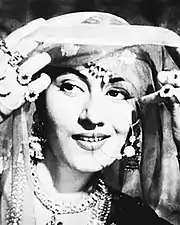
Mughal-e-Azam was released on 5 August 1960, and broke all the existing box office records in India and became the highest-grossing film at that time, a record that went unbroken for 15 years until the release of the Sholay in 1975. The film is still the highest-grossing film of all time, if adjusted against inflation. Madhubhala was nominated for a Filmfare Award for her performance in Mughal-e-Azam. However, Bina Rai won the award for Ghunghat.
After Mughal-e-Azam, Madhubala appeared in Barsaat Ki Raat. The film also stars Bharat Bhushan and Shyama. It became popular because of its star cast and the qawwalis featured in it. She played the role of Shabnam, a young and beautiful girl who falls in love with a struggling poet (Bharat Bhushan). Barsaat Ki Raat was the second highest-grossing film of 1960, and also made a place in the top 10 highest-grossing films of all time. The film was declared a blockbuster hit by Box Office India.
1960–64: Later career
In 1960s, Madhubala was at the peak of her career and popularity with the release of Mughal-e-Azam and Barsaat Ki Raat. She did have intermittent releases in the early 1960s. Some of these, such as Jhumroo (1961), Half Ticket (1962) and Sharabi (1964), performed above average at the box office.
Jhumroo is a romantic comedy film starring Madhubala and Kishore Kumar. The film is about Jhumroo, a tribal, who falls in love with Anjana, a wealthy woman whose father disapproves of the match. It turns out that Jhumroo's foster mother is Anjana's real mother, and her real father is her father's best friend. Her other releases of 1961 were Passport with Pradeep Kumar and Boy Friend with Shammi Kapoor. Both of the films were average performers at box office. Boy Friend was a remake of Kismet (1943).
Half Ticket is a musical comedy film again starring Madhubala with Kishore Kumar. The film is based on the Hollywood film You're Never Too Young. The film has hit songs such as "Chand Raat Tum Jo Saath" and "Aake Seedhi Lagi". Vijay (Kumar) is the good-for-nothing son of a rich industrialist, who becomes bored of his father's constant railing and the efforts to marry him off. Vijay leaves for Bombay to start life afresh. However, he doesn't have enough money for a ticket, so he decides to pass himself off as a child in order to get the eponymous half ticket. Now disguised as Munna, Vijay is used as a mule for a diamond smuggler (Pran) without his knowledge. On the train, Vijay also meets Rajnidevi (Madhubala) and falls in love with her. Suhana Geet, directed by Phani Majumdar featured Madhubala with her husband Kishore Kumar and brother-in-law Ashok Kumar. The film never saw the light of the day and remained incomplete.[33][34] She was replaced by Kalpana Mohan in Shakti Samantha's Naughty Boy.[27] She was offered several authored and powerful roles in films but had to withdraw from them owing to her poor heart condition.
Most of her other films released during this time were marred by her absence due to illness during filming and subsequent lack of completion. These films suffer from compromised editing, and in some cases the use of "doubles" in an attempt to patch-in scenes that Madhubala was unable to shoot.[35] Her last released film Jwala, although filmed in the late 1950s, was not released until 1971. It was released two years after her death.
Madhubala's co-stars Ashok Kumar, Raj Kapoor, Rehman, Pradeep Kumar, Shammi Kapoor, Dilip Kumar, Sunil Dutt and Dev Anand were the most popular actors of that period. She also appeared with notable leading ladies such as Kamini Kaushal, Suraiya, Geeta Bali, Nalini Jaywant, Shyama and Nimmi. The directors she worked with, Mehboob Khan (Amar), Guru Dutt (Mr. & Mrs. '55), Kamal Amrohi (Mahal) and K. Asif (Mughal-e-Azam), were amongst the most prolific and respected. Madhubala also became a producer and produced films like Naata (1955) and Mehlon Ke Khwab (1960) and acted in both the films.[36]
Other work
Film production
Madhubala produced three films: Naata (1955), Mehlon Ke Khwab (1960) and Pathan (1962).[37]
Playback singing
Madhubala did playback singing in her early days, when she worked as a child artist. She sang two songs in Basant (1942): Tumko Mubarak Oonche Mahal and Mere Chote Se Man Mein. In 1946, she also recorded a song for Pujari (1946).[38]
Charity
In 1950, Madhubala had donated ₹50,000 for refugees of East Bengal.[39]
Personal life
Relationships
In her biography, The Mystery and Mystique of Madhubala, freelance journalist and author, Mohan Deep wrote:
She was a woman possessed. Haunted by her own insecurities until the very end. She loved men. And lost them. Latif, Mohan Sinha, Kamal Amrohi, Premnath, Zulfiqar Ali Bhutto, Dilip Kumar, Kishore Kumar.
When Madhubala was a child, she had a friend called Latif. Before leaving for Mumbai, Madhubala gave him a red rose and an indication for their love. After she left, he became depressed. He kept the rose with himself and later became an Indian Administrative Service officer. When Madhubala died, he placed that red rose on her grave. He used to keep a red rose in her grave on 23 February every year until it was demolished.[40] This episode has been independently verified by another retired IAS officer, Manohar Subrahmanyam, who knew the real Latif as a fellow bureaucrat and who confirmed the story as true.[39]
Kamal Amrohi
After Kamal Amrohi's directed film Mahal (1949) became a turning point of Madhubala's career, they both began a relationship. Her father Ataullah Khan was aware of their relationship but he was in awe with Amrohi's great personality and said: "Aage chalke in dono ki shaadi ho jaye toh mujhe koi aitraaz nahi hai". (I have no objection if they both get married in future.) However, Amrohi was already married but still loved and wanted to marry Madhubala who refused to share with Amrohi's wife. Madhubala didn't want to share with Amrohi's second wife, Mehmoodi, and insisted that Amrohi divorce his wife. Amrohi was not willing to do so. He insisted that Madhubala must learn to share and said "Baatne se pyaar badta hai". (When you share your love, it expands its boundaries) But Madhubala didn't agree. It was also said that Madhubala put forward an outrageous deal where she offered to pay Amrohi, a sum amount of Rs. 900,000 to marry. However, he refused and they both ended their relationship. Her sister, Madhur Bhushan, refuted all such rumours and said: "Kamal Amrohi was a married man and given our economic conditions how could she, the sole earning member of our family, offer him Rs. 900,000".
Dilip Kumar
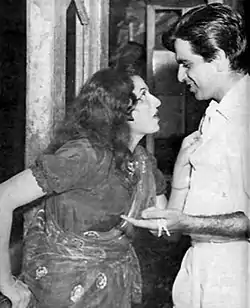
Dilip Kumar and Madhubala met each other on the sets of Tarana (1951) which starred them in lead roles. Her father stood between her and Kumar as he was worried were Madhubala to marry Dilip Kumar, he would lose the financial cushion that Madhubala had offered to her entire family as she was the sole breadwinner. Ataullah Khan was against the relationship as Madhubala had just started her career and earning huge amount of money for her roles. It has been said that Dilip Kumar insisted that if they were to marry, Madhubala would have to sever all ties with her family. The authenticity of this statement is questionable. Ataullah Khan allowed his daughter to interact with Dilip Kumar only on the sets. Both Kumar and Madhubala had to keep extreme care to their rendezvous hidden from the watchful eyes of Ataullah Khan. Kumar had felt it like a huge imposition.
Commenting on her choice of films, Dilip Kumar regrets that "had she lived, and had she selected her films with more care, she would have been far superior to her contemporaries..."[41] Kumar also points out that "actresses those days faced a lot of difficulties and constraints in their career. Unable to assert themselves too much, they fell back on their families who became their caretakers and defined everything for them."[42]
Marriage to Kishore Kumar (1960)
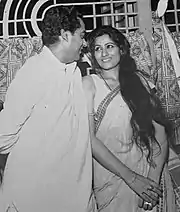
Madhubala met Kishore Kumar during the shooting of Dhake Ki Malmal (1956). In 1960, Madhubala married him when she was 27 years old. When Madhubala was ill in the late 1950s with the congenital heart disease, Kishore Kumar proposed to her and she decided to marry him after realising that Dilip Kumar was not going to marry her. Kishore Kumar's family never accepted her in their family because Kishore Kumar married Madhubala as per his own wish. The couple had a Hindu ceremony to please Kumar's family but Madhubala was never truly accepted as his wife. Reportedly, Kishore Kumar converted himself into Islam and changed his legal name to "Karim Abdul" to marry her.[43] However, in an interview given to Filmfare, he said that neither he nor Madhubala ever changed their religion to marry each other. They went to London soon after their marriage for their honeymoon where the doctor told her that she had only two years to live. According to Madhubala's sister, Madhur Bhushan, after returning India, Kishore Kumar bought a flat for Madhubala at Quarter Deck, Carter's Road, Bandra, where they stayed for a while and then, he left her there with a nurse and a driver.[44] He would visit Madhubala once in two months and said he couldn't look after her. But he never abused her as was reported and bore her medical expenses. She added "Often Kishore bhaiya's phone was disconnected. He'd visit her once in two to three months. He'd say, 'If I come, you'll cry and it'll not be good for your heart. You'll go into depression. You should rest'. She was young and jealousy was natural. Perhaps, a feeling of being abandoned killed her". Their marriage lasted for nine years. After Madhubala died in 1969 at the age of 36, Kishore Kumar married actress Yogeeta Bali in 1976.[45]
Controversies on Madhubala's life
In their 1962 book Self-Portrait, Harish Booch and Karing Doyle commented that "Unlike other stars, Madhubala prefers a veiled secrecy around her and is seldom seen in social gatherings or public functions." (p. 76), and went on to say that "Contrary to general belief, Madhubala is rather simple and unassuming" (p. 78).[17][46] This is echoed in her sister's interview with Filmfare: "(Madhubala) became a craze because she was never seen in public. She wasn't allowed to attend any function, any premiere. She had no friends. But she never resisted, she was obedient. Being protective, my father earned the reputation of being domineering".[47] Dilip Kumar added: "She was extremely popular... and I think the only star for whom people thronged outside the gates. Very often when shooting was over, there'd be a vast crowd standing at the gates just to have a look at Madhu... It wasn't so for anyone else. That was her personal effect on fans. Her personality was vivacious."[48] But, "She was aware of her beauty," reminisces B. K. Karanjia, former Filmfare editor and a close friend of both Madhubala and her father, "and because there were so many in love with her, she used to play one against the other. But it was out of innocence rather than shrewd calculation."[49] Dev Anand recalled in a similar way: "She liked to flirt innocently and was great fun."[50][51] However, with Dilip Kumar she had a long association.
Dilip Kumar and Madhubala first met on the set of Jwar Bhata when she was 11 years of age, and worked together again on the film Har Singaar (1949), which was shelved. Their relationship began two years later during the filming of Tarana (1951). But she had to give the courtship with Dilip due to her father's opposition to him. They became a romantic pair appearing in a total of four films together. Actor Shammi Kapoor recalled that during the shooting of Naqab (1955), "Dilip Kumar would drive down from Bombay to meet Madhubala... he even flew to Bombay to spend Eid with her, taking time off from his shooting stint..."[52][47] But, Madhubala's father Ataullah Khan initially did not give them permission to marry.[53] Dilip Kumar said: "She was a very, very obedient daughter",[54] and who, in spite of the success, fame and wealth, submitted to the domination of her father and more often than not paid for his mistakes.[55] "This inability to leave her family was her greatest drawback", believed Shammi Kapoor, "for it had to be done at some time."[56]
Dilip Kumar later revealed that her father eventually gave them permission to marry and was "glad to have two stars under the same roof." However, her father, who owned his own production company, wanted to make "a business venture out of their proposed marriage" according to Dilip Kumar, which he did not approve of, after which the relationship began turning sour.[57] The Naya Daur court case happened in 1956 when Dilip Kumar testified against Madhubala and her father in favour of director B.R. Chopra in open court. This struck a fatal blow to the Dilip-Madhubala relationship as it ended any chance of reconciliation between Dilip Kumar and Madhubala's father.[58] Reflecting on this, while Kumar said he was "trapped",[59] Shammi Kapoor felt "this was something which went beyond him (Dilip) and he couldn't control the whole situation..."[60]
Madhubala married Kishore Kumar in 1960.[61] According to Leena Chandavarkar (Kishore's fourth wife): "When she realized Dilip was not going to marry her, on the rebound and just to prove to him that she could get whomsoever she wanted, she went and married a man she did not even know properly."[62] B. K. Karanjia assumed that "Madhubala may have felt that perhaps this was her best chance" because by this time she became seriously ill, and was about to stop working completely; however, he added that "it was a most unlikely union, and not a happy one either."[63]
Madhubala's illness was known to Kishore, but like all the others, he did not realise its gravity; Ataullah Khan did not approve of his son-in-law at all, but he had lost the courage to disapprove.[64] Ashok Kumar reminisced in a Filmfare interview: "She suffered a lot and her illness made her very bad-tempered. She often fought with Kishore, and would take off to her father's house where she spent most of her time."[65]
However, Madhubala's love-life continued to be the subject of media speculation. Mohan Deep wrote an unofficial biography of Madhubala titled Mystery and Mystique of Madhubala, published in 1996, where he claims that Kishore Kumar regularly whipped Madhubala, who would show her lashes to Shakti Samanta. He also claimed that the versions about Madhubala's sickness and death provided by her family members did not match with those provided by Kishore Kumar's family members and the fact that Madhubala was forced to wear heavy shackles and whipped mercilessly in real life in the secret version of Mughal-e-Azam is proved by the fact that only a minor part of the total number of reels shot were released for public. However, the secret version of the film earned Kishore Kumar a lot of money that he earned forcing Madhubala to work as a sex slave in the secret version of the movie.[66] Mohan Deep also questions whether Madhubala was really ill or her ailing was a fiction.[67] The book was heavily criticised on its release by industry veterans such as Shammi Kapoor, Shakti Samanta and Paidi Jairaj.[49]
Final years and death
Madhubala had a ventricular septal defect (a hole in her heart) which was detected while she was shooting for Bahut Din Huwe in Madras in 1954.[68] This was in the era before open heart surgeries were possible. The natural history of an unrepaired ventricular septal defect leads to pulmonary hypertension and Eisenmenger's syndrome. At this stage the hole cannot be repaired. Hence, she could never undergo a heart surgery later in life, when open heart surgeries were possible in some Western countries like the United States. By 1960, her condition had become aggravated, and as her sister Madhur Bhushan explains that due to her ailment, her body would produce extra blood, so it would spill out from her nose and mouth. The doctor would come home and extract bottles of blood. As a result of the ventricular septal defect, blood would bypass her lungs leading to low oxygen levels and giving her a blue discoloration. As a compensatory mechanism, the body produced more red blood cells making the blood too thick. Hence, the doctors had to extract the excess blood to prevent complications. She was confined to bed for nine years and was reduced to just bones and skin. Unfortunately, there was no surgery or medicine available at that time to treat her.
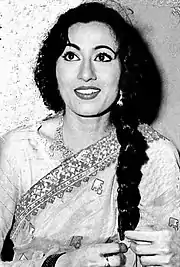
In 1966, with a slight improvement in her health, she made a valiant attempt to complete her work in Chalaak opposite Raj Kapoor, which needed only a short spell of shooting, but she could not even survive that strain.[69] When acting was no longer an option, Madhubala turned her attention to film direction. In 1969, she was set to make her directorial debut with the film Farz aur Ishq. However, the film was never made, as during pre-production, she died on 23 February 1969, shortly after her 36th birthday. The cause of death was determined to be the prolonged lung and heart illness.[70][71]
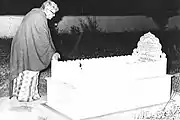
Madhubala's funeral was not attended by Dilip Kumar and this is not known if he was invited. She was buried at Juhu Muslim Cemetery in Santacruz, Mumbai. Her tomb was built with marbles and inscriptions include aayats from Qur'an and verse dedications. In 2010, her tomb along with those of Mohammed Rafi, Parveen Babi, Talat Mahmood, Naushad Ali and Sahir Ludhianvi, was demolished to make way for newer graves. Her remains were placed at an unknown location.[72][73]
Legacy and honours
Fashioned like a delicate flower, and as fragrant and pretty, Madhubala had behind this facade of disarming helplessness, a reserve of strength and courage and determination that was astounding in one so young and sheltered.
— Cineplot
Madhubala's strong presence in the public memory has been evidenced by all recent polls about top actresses or beauties of the Indian cinema.[2][74] Every year, numerous articles are printed and television programmes aired to commemorate her birthday. Madhubala is idolised by several new actresses and her posters are still in demand and sold alongside contemporary actresses such as Meena Kumari, Nargis, Waheeda Rehman and Nutan. Modern magazines continue to publish stories on her personal life and career, often promoting her name heavily on the covers to attract sales. In Rediff.com's International Women's Day 2007 special, Madhubala was ranked second in its top ten list of "Bollywood's best actresses".[75] Many believe, however, that Madhubala remains one of the most underrated actresses as "her beauty attracted more attention than her talent."[76]
In 2004, a digitally-colorized version of the original Mughal-e-Azam was released, 35 years after her death. This version was too a success.
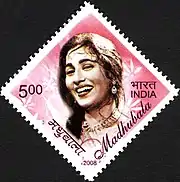
On 18 March 2008, a commemorative postage stamp featuring Madhubala was issued.[77][78] The stamp was produced by India Post in a limited edition presentation pack. It was launched by veteran actors Nimmi and Manoj Kumar in a ceremony attended by colleagues, friends and surviving members of Madhubala's family. The only other Indian film actress that was honoured in this manner was Nargis Dutt, at that point of time.[79]
In 2012, her 1962 release Half Ticket was also remastered, digitally coloured and re-released after 50 years of its original release.
On 10 August 2017, the New Delhi center of Madame Tussauds unveiled a statue of Madhubala inspired by her look in the film Mughal-E-Azam (1960) as a tribute to her.[80][81]
In 2018 the New York Times published a belated obituary for her.[82]
On 14 February 2019, search engine Google commemorated Madhubala with a Doodle on her 86th birth anniversary.[83][84][85][86][87] Google commented: "While her breathtaking appearance earned comparisons to Venus, Madhubala was a gifted actor with an understated style well suited for comedies, dramas, and romantic roles alike. Appearing in over 70 films over the course of a tragically brief career, Madhubala—who would have turned 86 today—was called "The Biggest Star in the World" in 1952 by Theatre Arts Magazine."[88]
Fashion icon and diva
Madhubala was known as a trendsetter and creator of iconic fashion styles, followed by many celebrities, even after her death.[89]
Awards and nominations
Despite the fact that Madhubala eventually became an iconic actress of Hindi cinema, she had never received any awards, unlike her contemporaries Meena Kumari, Vyjayanthimala, Nutan, Waheeda Rehman, Suraiya and Nargis.
Madhubala received her only nomination for a Filmfare Award for Best Actress in 1961 for her performance in Mughal-e-Azam.[90]
Selected filmography
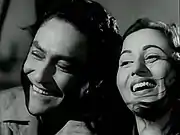
Madhubala appeared in total number of 74 films. In a career spanning 22 years, she also produced two films and sang some songs in her early films. Some of her films are listed below.
| Year | Film | Role | Notes |
|---|---|---|---|
| 1942 | Basant | Manju | Credited as Baby Mumtaz
Sang a song |
| 1947 | Neel Kamal | Ganga | First film as a heroine
Credited as "Mumtaz" |
| 1949 | Mahal | Kamini/Asha | Turning point of her career |
| 1950 | Hanste Aansoo | Usha | First Indian film to get an 'A' certificate |
| 1951 | Tarana | Tarana | |
| 1952 | Sangdil | Kamla | |
| 1954 | Bahut Din Huwe | Chandrakanta | While its shooting, her illness was discovered |
| Amar | Anju Roy | ||
| 1955 | Naata | Tara | First film as a producer |
| Mr. & Mrs. '55 | Anita Verma | ||
| 1958 | Phagun | Banani | |
| Kala Pani | Asha | ||
| Howrah Bridge | Edna | ||
| Chalti Ka Naam Gaadi | Renu | ||
| 1960 | Mehlon Ke Khwab | Asha | Also the producer of the film |
| Barsaat Ki Raat | Shabnam | ||
| Mughal-e-Azam | Anarkali | Nominated—Filmfare Award for Best Actress | |
| 1962 | Half Ticket | Rajnidevi/Asha | |
| 1964 | Sharabi | Kamala | Last film to be released before her death |
| 1971 | Jwala | Princess Jwala | Released posthumously Only colour film |
In film
In July 2018, Madhubala's sister, Madhur Bhushan, announced that she was planning to make a biopic on her sister. She will not be directing the film but has urged other filmmakers not to plan any biopics on the same subject. Bhushan wants Kareena Kapoor Khan to play Madhubala's role onscreen. However, as of now, the project remains at the initial stages.[91][92][93][94]
In November 2019, it was reported that filmmaker Imtiaz Ali is planning to make a biopic of Madhubala. However, he dropped the idea of making the biopic after her family denied of making one.[95]
References
- Says, Justin. "Madhubala – The Biggest Star in The World – Cineplot.com". Retrieved 3 December 2020.
- "Poll: Most Popular Actress". filmfare.com. 30 April 2013. Archived from the original on 12 July 2018. Retrieved 9 March 2018.
- Bhagat, Rasheeda (31 May 2011). "Madhubala's timeless beauty". Business Line. Archived from the original on 26 December 2016. Retrieved 27 December 2014.
- "Remembering Madhubala, the 'Marilyn Monroe of Bollywood'". India Today. Archived from the original on 26 April 2019. Retrieved 31 August 2019.
- Booch, Harish and Doyle, Karing.(1962). Self-Portraitt. Bombay: Jai Gujerat Press. pp. 75-78.
- Gangadhar, V. (17 August 2007). "They now save for the rainy day". The Hindu. Archived from the original on 8 October 2011. Retrieved 5 October 2011.
- Khan, Javed (18 January 2015). "Madhubala: From Peshawar with love ..." DAWN.COM. Archived from the original on 20 April 2018. Retrieved 20 April 2018.
- Cert, David: "The Biggest Star in the World – and she's not in Beverly Hills" Archived 28 September 2011 at the Wayback Machine, Theatre Arts (August 1952)
- Lanba, Urmila. (2012). Bollywood's Top 20: Superstars of Indian Cinema (Patel, B, ed.). p.115.
- "Top 20: Things you didn't know about Madhubala". News18. Archived from the original on 31 August 2019. Retrieved 31 August 2019.
- "Madhubala" Archived 8 October 2014 at the Wayback Machine, Upperstall.com. Retrieved 19 April 2013
- Vinod Mehta (31 July 2013). "Meena Kumari". Books.google.com. Archived from the original on 12 October 2020. Retrieved 25 July 2016.
- admin (16 April 2016). "Madhubala – Her Sister's Recollections". Cineplot.com. Archived from the original on 17 September 2016. Retrieved 19 August 2016.
- Akbar, Katijia (1 April 2011). I Want to Live: The Story of Madhubala. Hay House, Inc. ISBN 978-93-81398-21-0.
- "In Black and White: The films that left a mark in 1947". hindustantimes.com. Retrieved 22 October 2020.
- "I still regret saying no to Raj Kapoor for Satyam Shivam Sundaram". Rediff. Retrieved 22 October 2020.
- Patel, B. (1952). Stars of the Indian Screen. Bombay: Parker & Sons.
- "Lal Dupatta (1948) – Review – Cineplot.com". Retrieved 22 October 2020.
- "Lal Dupatta (1948) Press Advert - www.desimovies.biz | Sunday morning show, Adverts, Pressing". Pinterest. Retrieved 28 September 2020.
- "The Queen of Hearts". archive.indianexpress.com. Retrieved 7 October 2020.
- FilmIndia (1949). New York The Museum of Modern Art Library. Bombay. 1949.CS1 maint: others (link)
- Akbar, Katijia (1 April 2011). I Want to Live: The Story of Madhubala. Hay House, Inc. ISBN 978-93-81398-21-0.
- http://www.citwf.com/film%5B%5D 96447.htm, 1949 film Dulari on C.I.T.W.F. website, Retrieved 24 May 2016
- http://beaninspirer.com/madhubala-an-actress-so-beautiful-that-the-world-couldn't-digest-it/
- Karanjia, B.K. (2005). Counting My Blessings. New Delhi: Penguin. p. 246-47
- "Rediff on the Net, Movies: An interview with Shammi, the heartthrob of the '50s". m.rediff.com. Archived from the original on 23 August 2016. Retrieved 20 October 2018.
- "Archived copy". Archived from the original on 21 April 2019. Retrieved 11 November 2018.CS1 maint: archived copy as title (link)
- Lanba, Urmila. (2012). Bollywood's Top 20: Superstars of Indian Cinema (Patel, B, ed.). p.116.
- Bali, Karan (18 June 2019). "Jaali Note". Upperstall.com. Retrieved 28 January 2021.
- Reuben, Bunny (2004). Dilip Kumar: Star Legend of Indian Cinema. Delhi: Harper Collins
- Akbar, Khatija (2011). I Want to Live: The Story of Madhubala (Kindle Locations 1811–1812). Hay House. Kindle Edition.
- Akbar, Khatija (2011). I Want to Live: The Story of Madhubala (Kindle Locations 2200–2202). Hay House. Kindle Edition.
- "Suhana Geet (1963)". MuVyz. Archived from the original on 29 August 2019. Retrieved 29 August 2019.
- "Baaje re Kahin Bansuriya - Kishore Kumar (Unreleased song)". YouTube. 28 August 2019. Archived from the original on 12 October 2020. Retrieved 29 August 2019.
- Filmfare, 13–26 May 1977, p. 41.
- "Madhubala: A sweet seduction". Rediff.com. October 2002. Archived from the original on 7 July 2012. Retrieved 2 June 2012.
- Deep, Mohan (1996). The Mystery and Mystique of Madhubala. Magna Books. p. 15.
- "Songs from Pujari (1946)". www.cinestaan.com. Retrieved 8 December 2020.
- Subrahmanyam, Manohar (5 January 2015). "The unknown side of Madhubala". ActiveIndiaTV.com. Archived from the original on 21 August 2017. Retrieved 1 April 2020.
- http://amp/s/www.hersociety.com/amp/society-culture/the-tragic-love-affairs-of-madhubala-the-venus-queen-article-83000%5B%5D
- Akbar, Khatija (2011). I Want to Live: The Story of Madhubala (Kindle Locations 1478–1479). Hay House. Kindle Edition.
- Akbar, Khatija (2011). I Want to Live: The Story of Madhubala (Kindle Locations 1472–1473). Hay House. Kindle Edition.
- Kishore, First Post
- http://amp/s/m.filmfare.com/news/bollywood/madhubalas-sister-Madhur-bhushan-reveals-the-most-shocking-details-about-the-late-actors-life-25267.amp%5B%5D
- http://www.indiatoday.in/amp/movies/celebrities/story/madhubala-kishore kumar-marriage-what-you-need-to-know
- Booch, H. & Doyle, K. (1962). Star Portrait. Bombay:Jai Gujerat Press
- "‘‘Madhubala was sad when Dilip Kumar got married – Madhur Bhushan". filmfare.com. Archived from the original on 7 June 2013. Retrieved 9 March 2018.
- Akbar, Khatija (2011). I Want to Live: The Story of Madhubala (Kindle Locations 804-806). Hay House. Kindle Edition.
- "'It's in Bad Taste'". Outlookindia.com. 10 July 1996. Archived from the original on 12 November 2013. Retrieved 9 March 2018.
- Akbar, Khatija (2011). I Want to Live: The Story of Madhubala (Kindle Locations 1370–1371). Hay House. Kindle Edition.
- Lanba, Urmila. (2012). Bollywood's Top 20: Superstars of Indian Cinema (Patel, B, ed.). p. 121
- Akbar, Khatija (2011). I Want to Live: The Story of Madhubala (Kindle Locations 2506–2510)
- Karanjia, B. K. (2005). Counting My Blessings. New Delhi: Harper Collins. pp. 246
- Akbar, Khatija (2011). I Want to Live: The Story of Madhubala (Kindle Locations 2551–2552). Hay House. Kindle Edition.
- Akbar, Khatija (2011). I Want to Live: The Story of Madhubala (Kindle Locations 721-722). Hay House. Kindle Edition.
- Akbar, Khatija (2011). I Want to Live: The Story of Madhubala (Kindle Location 2555). Hay House. Kindle Edition.
- "Dilip Kumar reveals why he did not marry Madhubala in autobiography". India Today. 15 June 2014. Archived from the original on 20 December 2017. Retrieved 16 December 2017.
- Akbar, Khatija (2011). I Want to Live: The Story of Madhubala (Kindle Location 1164–1178). Hay House. Kindle Edition.
- Akbar, Khatija (2011). I Want to Live: The Story of Madhubala (Kindle Location 1157). Hay House. Kindle Edition.
- Akbar, Khatija (2011). I Want to Live: The Story of Madhubala (Kindle Locations 2764–2765). Hay House. Kindle Edition.
- Kishore Kumar, First Post, archived from the original on 24 September 2015, retrieved 29 June 2015
- Akbar, Khatija (2011). I Want to Live: The Story of Madhubala (Kindle Locations 2692–2696). Hay House. Kindle Edition.
- Karanjia, B.K. (2005). Counting My Blessings. New Delhi: Penguin. p. 246
- Akbar, Khatija (2011). I Want to Live: The Story of Madhubala (Kindle Locations 2706–2708). Hay House. Kindle Edition.
- Filmfare, November 1992. p.71
- Deep, Mohan (1996) The mystery and mystique of Madhubala, p. 109.
- Deep, Mohan (1996) The mystery and mystique of Madhubala.
- Filmfare, 30 August 1957, p. 7
- Akbar, Khatija (2011). I Want to Live: The Story of Madhubala (Kindle Locations 2754–2755). Hay House. Kindle Edition.
- http://www.jhakaasmovies.com/amp/did-you-know/how-did-madhubala-died.html%5B%5D
- "What Killed Madhubala: A Close Look at the Death of A Bollywood Icon". Mr. & Mrs. 55 - Classic Bollywood Revisited!. 5 February 2013. Archived from the original on 12 May 2019. Retrieved 31 August 2019.
- http://amp/s/m.timesofindia.com/city/mumbai/Rafi-Madhubala-don't-rest-in-peace-here/m_articleshow/5558345.cms%5B%5D
- http://amp/s/topyaps.com/madhubala-rafi-tombs-demolished/amp%5B%5D
- Lanba, Urmila. (2012). Bollywood's Top 20: Superstars of Indian Cinema (Patel, B, ed.). p. 126.
- "Bollywood's best actresses. Ever. (Wet, wild and on the run, honey)". Rediff.com. Archived from the original on 24 May 2012. Retrieved 2 June 2012.
- Lanba, Urmila. (2012). Bollywood's Top 20: Superstars of Indian Cinema (Patel, B, ed.). p.118.
- Bhagria, Anupam (18 May 2008). "Postal stamp released on the legendary Madhubala". The Indian Express. Archived from the original on 22 January 2013. Retrieved 2 June 2012.
- "Postal stamp in memory of Madhubala". Oneindia. 19 March 2008. Archived from the original on 31 August 2019. Retrieved 31 August 2019.
- Mihir, Trivedi (19 March 2008). "Postal Dept. stamps yesteryear star Madhubala". IBN Live. Archived from the original on 17 May 2012. Retrieved 2 June 2012.
- "Madhubala, As Anarkali, Unveiled in Madame Tussauds Delhi". NDTV.com. Archived from the original on 31 August 2019. Retrieved 31 August 2019.
- "Photos: Madhubala's wax figure unveiled at Madame Tussauds Delhi". 10 August 2017. Archived from the original on 31 August 2019. Retrieved 31 August 2019.
- Aisha Khan. "Madhubala, a Bollywood Legend Whose Tragic Life Mirrored Marilyn Monroe's – The New York Times". Nytimes.com. Archived from the original on 8 March 2018. Retrieved 9 March 2018.
- "Google doodle pays a beautiful tribute to Madhubala on her 86th birth anniversary". Times Now. 14 February 2019. Archived from the original on 14 February 2019. Retrieved 14 February 2019.
- "Valentines Day 2019: Google doodle sends love bugs, honors Madhubala".
- "Madhubala featured in Google doodle". Prothom Alo. Archived from the original on 31 August 2019. Retrieved 31 August 2019.
- "Madhubala: Google pays tribute to Madhubala on 86th birth anniversary with doodle". m.economictimes.com. Archived from the original on 31 August 2019. Retrieved 31 August 2019.
- "Madhubala-Google Doodle on 86th Birthday of The Venus of Indian Cinema". Devdiscourse. Archived from the original on 31 August 2019. Retrieved 31 August 2019.
- "Madhubala's 86th Birthday". Google. 14 February 2019. Archived from the original on 14 February 2019. Retrieved 14 February 2019.
- "6 Iconic fashion statements we owe to Madhubala!". Times of India. 14 February 2019. Archived from the original on 15 February 2019. Retrieved 15 February 2019.
- Bhagat, Rasheeda (31 May 2011). "Madhubala's timeless beauty". Business Line. Archived from the original on 7 December 2019. Retrieved 27 December 2014.
- http://amp/s/m.hindustan.comes/bollywood/after-sanju-a-biopic-on-iconic-actor-madhubala-no-names-revealed-yet/story-gkbnZK60nKOcR8F4nF5TAO_amp.html
- "Madhubala's Sister To Make A Biopic on Actress. Details Here". ndtv. 8 July 2018. Archived from the original on 9 July 2018. Retrieved 10 July 2018.
- http://amp/s/tribune.com.pk/story/1753299/4-biopic-late-actor-madhubala-works/%3famp=1%5B%5D
- "Janhvi Kapoor would love to play Meena Kumari or Madhubala". indianexpress. 14 July 2018. Archived from the original on 14 July 2018. Retrieved 14 July 2018.
- World, Republic. "Imtiaz Ali has officially dropped the Madhubala biopic project; check details". Republic World. Archived from the original on 12 October 2020. Retrieved 8 September 2020.
Further reading
- Akbar, Khatija (1997). Madhubala: her life, her films. UBS Publishers Distributors. ISBN 978-81-7476-153-8.
- Akbar, M. J. Sunday Magazine, 5 August 1996
- Bajaj, Rajiv K. (ed.). The Daily, 26 May 1996
- Bhattacharya, Rinki. Bimal Roy: A man of silence, South Asia Books
- Cort, David. Theatre Arts magazine, Issue Date: August 1952; Vol. XXXVI No. 8
- Deep, Mohan. Madhubala: The Mystery and Mystique, Magna Publishing Co. Ltd.
- Joshi, Meera. Madhubala: Tears in Heaven Filmfare, 14 May 2008
- Kamath M.V. The Daily, June 1996
- Karanjia, B.K. Dates with Diva, Deccan Chronicle, 17 December 2006
- Khan, Aisha. "Madhubala, 1933-1969," New York Times, 8 March 2018.
- Raheja, Dinesh. The Hundred Luminaries of Hindi Cinema, India Book House Publishers
- Rajadhyaksha, Ashish; Willemen, Paul. The Encyclopedia of Indian Cinema, Fitzroy Dearborn Publishers
- Reuben, Bunny. Follywood Flashback, Indus publishers
- Sawhney, Clifford. Debonair', June 1996
- Singh, Khushwant. Sunday Observer 23–29 June 1996
External links
| Wikimedia Commons has media related to Madhubala. |
- Madhubala at IMDb
- Madhubala at the Encyclopædia Britannica